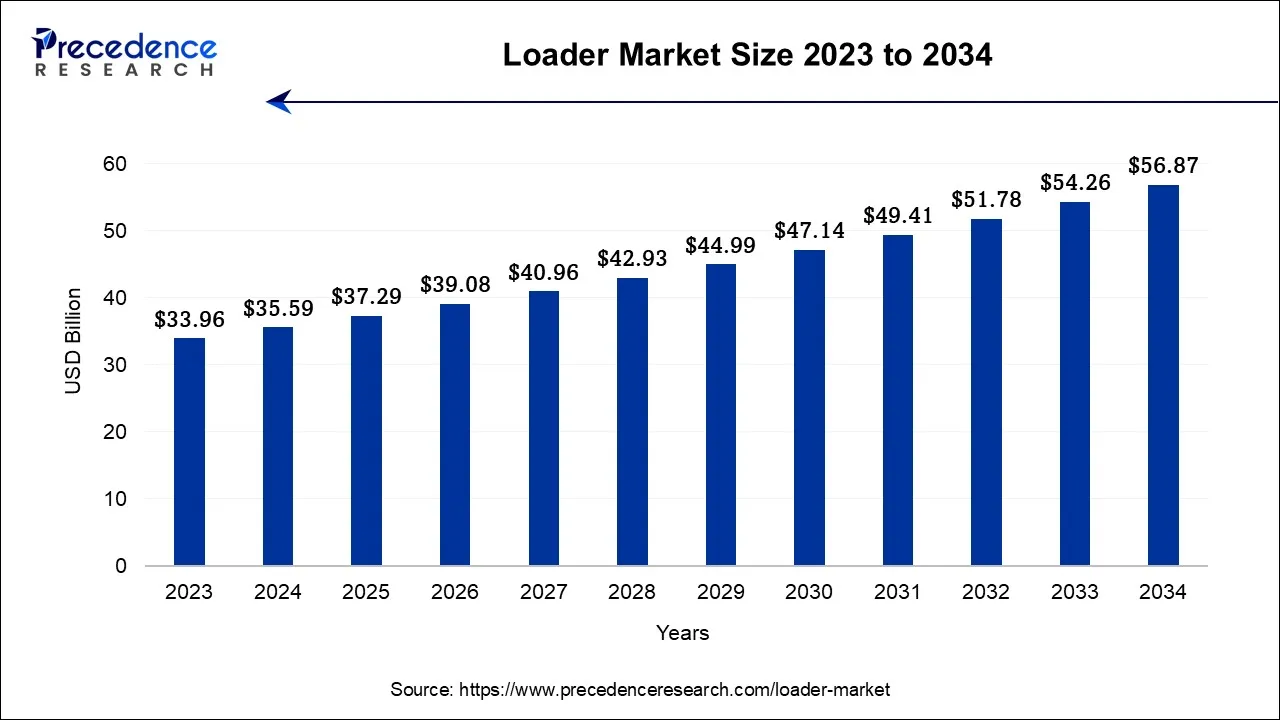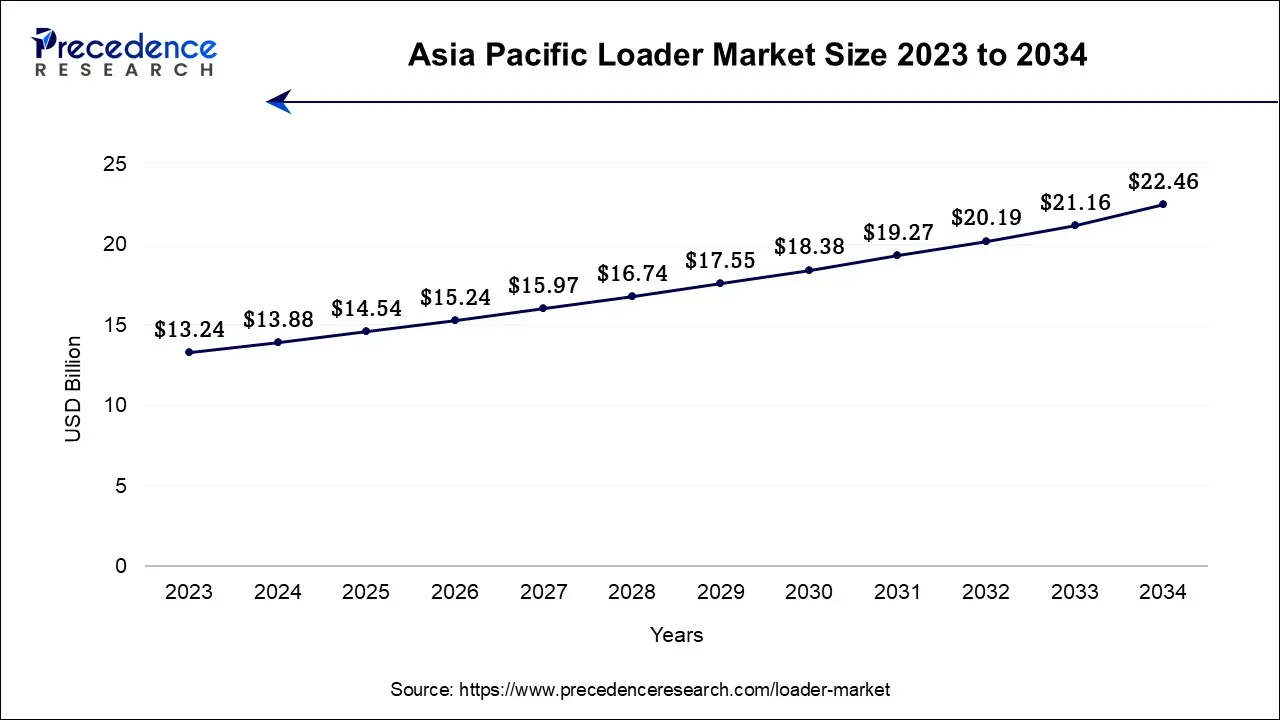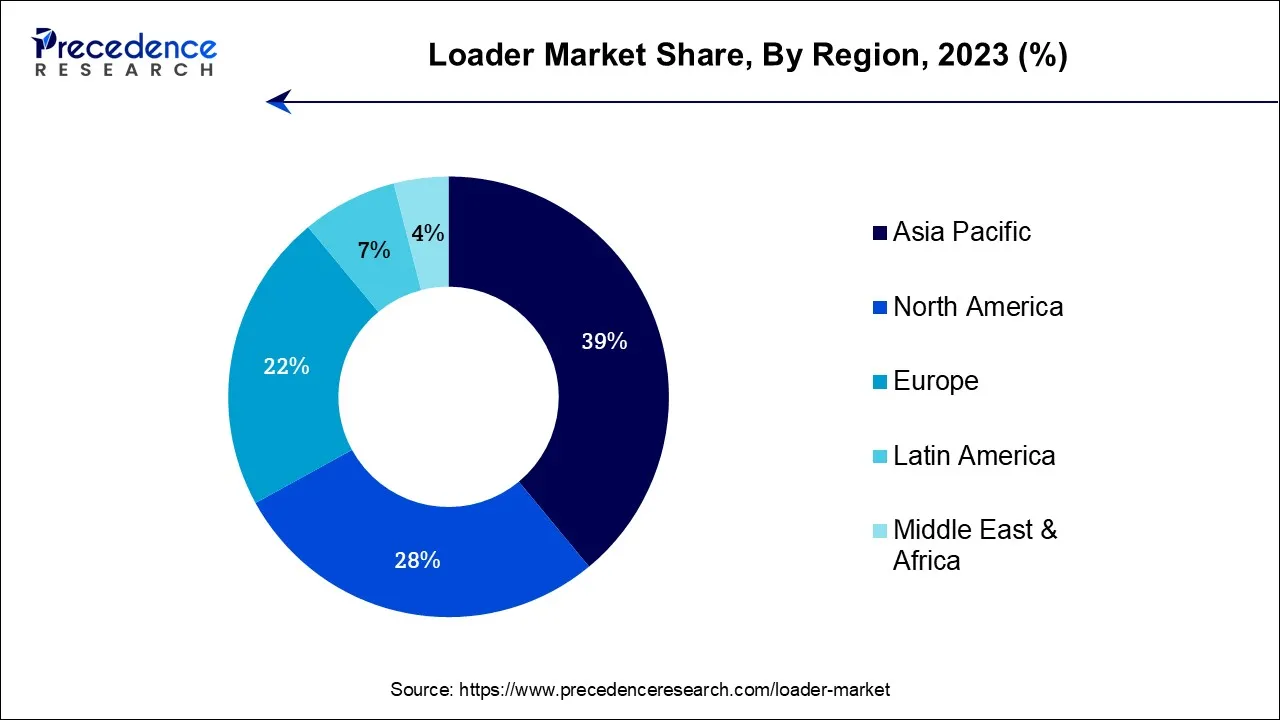The global loader market size is calculated at USD 35.59 billion in 2024, grew to USD 37.29 billion in 2025, and is predicted to hit around USD 56.87 billion by 2034, poised to grow at a CAGR of 6.8% between 2024 and 2034. The Asia Pacific loader market size accounted for USD 13.88 billion in 2024 and is anticipated to grow at the fastest CAGR of 6.97% during the forecast year.
The global loader market size is expected to be valued at USD 35.59 billion in 2024 and is anticipated to reach around USD 56.87 billion by 2034, expanding at a CAGR of 6.8% over the forecast period from 2024 to 2034.

The Asia Pacific loader market size is accounted for USD 13.88 billion in 2024 and is projected to be worth around USD 22.46 billion by 2034, poised to grow at a CAGR of 6.97% from 2024 to 2034.

Asia-Pacific has held the largest revenue share at 39% in 2023. In the Asia-Pacific region, the loader market is witnessing robust growth due to extensive infrastructure development projects in countries like China and India. Rapid urbanization, coupled with increased construction activities, is driving demand for loaders. Additionally, the agricultural sector's mechanization and the growth of the mining industry contribute to the market's expansion. Manufacturers are also focusing on introducing technologically advanced and environmentally friendly loaders to meet evolving customer preferences and stringent regulations in the region.

Europe is estimated to observe the fastest expansion. In Europe, the loader market is experiencing several noteworthy trends. The demand for loaders remains strong due to ongoing construction projects and infrastructure development across the continent. Additionally, there is a growing emphasis on sustainability, with manufacturers increasingly focusing on eco-friendly loader models. Technological integration, such as automation and telematics, is also on the rise, enhancing loader efficiency and operator safety. Europe's loader market reflects a commitment to modernization, environmental responsibility, and improved machinery performance.
| Report Coverage | Details |
| Market Size in 2024 | USD 35.59 Billion |
| Market Size by 2034 | USD 56.87 Billion |
| Growth Rate from 2024 to 2034 | CAGR of 6.8% |
| Largest Market | Asia-Pacific |
| Base Year | 2023 |
| Forecast Period | 2024 to 2034 |
| Segments Covered | By Loader Type, By Payload Capacity, and By Application |
| Regions Covered | North America, Europe, Asia-Pacific, Latin America, and Middle East & Africa |
Technological advancements are a significant driver of market demand in the loader industry. Integration of advanced technologies like GPS for precise navigation, telematics for remote monitoring, IoT connectivity for data analysis, and automation for increased efficiency and safety have revolutionized loader operations. These innovations enhance productivity, reduce operating costs, and improve operator comfort. As industries increasingly adopt these advanced features, the demand for modern, tech-enabled loaders continues to rise, sustaining market growth.
Moreover, emissions regulations drive demand in the loader market as they push manufacturers to develop advanced, safe, more fuel-efficient equipment. Compliance with stringent emission standards ensures environmental responsibility and aligns with sustainability goals. This compels industries to invest in newer, eco-friendly loaders, resulting in increased market demand for greener machinery.
The high initial cost of loaders acts as a significant restraint on market demand. Potential buyers, especially smaller businesses, and contractors with limited budgets, may find it challenging to afford these capital-intensive machines. This financial barrier can lead to delayed or postponed purchase decisions, limiting market growth.
Buyers often seek alternative equipment options or used loaders, impacting sales volume, and affecting the overall market dynamics, particularly in regions with budget-conscious customers. Additionally, maintenance expenses deter market demand for loaders as they contribute significantly to the total cost of ownership. High maintenance costs burden buyers and operators, impacting profitability and return on investment. This can lead potential customers to seek more cost-effective alternatives or delay equipment purchases, slowing market growth, which restrains the demand for the loader market.
Customization in the loader market caters to diverse industry needs, increasing market demand. Tailored loader configurations enable buyers to choose equipment that precisely fits their specific applications, enhancing operational efficiency and productivity. This flexibility attracts a broader customer base, driving demand for loaders with personalized features and capabilities. Moreover, the rental market boosts demand for loaders as it offers a cost-effective alternative to purchasing.
Construction companies and industries often prefer renting loaders for short-term projects to minimize upfront costs and maintenance responsibilities. This dynamic expands the customer base, increasing market demand as rental companies frequently update their fleets to meet client needs, driving the purchase of new loaders. Additionally, it allows potential buyers to test different loader models before making a purchase decision, further stimulating demand.
According to the loader type, the wheeled loader segment has held a 32.1% revenue share in 2023. A wheeled loader is a type of heavy equipment used in construction, mining, and material handling. It features wheels for mobility and a front-mounted bucket or attachment for tasks such as digging, lifting, and loading materials. In the loader market, the trend for wheeled loaders includes the integration of advanced technology like GPS for precise operation, improved fuel efficiency, and reduced emissions to meet environmental regulations. Manufacturers are also focusing on operator comfort and safety through ergonomic cab designs and enhanced visibility.
The hardware sector is anticipated to expand at a significant CAGR of 6.2% during the projected period. Mini loaders, also known as compact loaders, are a type of loader characterized by their smaller size and maneuverability. They are versatile machines used in construction, landscaping, agriculture, and material handling tasks. In the loader market, the trend toward mini loaders is driven by the need for compact equipment that can access confined spaces. Technological advancements, such as improved ergonomics and enhanced safety features, have further boosted the popularity of mini loaders for various applications, including urban construction and landscaping projects.
By payload capacity, the 6-10 tons segment is anticipated to hold the largest market share of 29% in 2023. In the loader market, loaders with a payload capacity of 6-10 tons represent a versatile category that caters to a wide range of applications. These loaders are commonly used in construction, mining, and material handling operations. Recent trends indicate a growing demand for fuel-efficient and eco-friendly loaders within this payload capacity range, driven by environmental regulations. Manufacturers are also integrating advanced technologies, such as telematics and automation, to enhance operational efficiency and safety in this segment.
On the other hand, the 3-5 tons segment is projected to grow at the fastest rate over the projected period. In the loader market, loaders with a payload capacity of 3-5 tons are versatile workhorses used across various industries. They efficiently handle medium to heavy-duty tasks such as loading and transporting materials in construction, mining, and logistics sectors. A notable trend in this segment is the integration of advanced technology, including telematics for real-time monitoring and automation for improved efficiency. Loader manufacturers are also focusing on enhancing operator comfort and reducing emissions to align with stringent environmental regulations, driving sustainable growth.
In 2023, the construction sector had the highest market share of 36.8% on the basis of the application. In the loader market, the construction segment pertains to the use of loaders in various construction activities, including earthmoving, material handling, and site preparation. A notable trend in this segment is the integration of advanced technology, such as GPS and telematics, to enhance precision and productivity. Additionally, loaders designed for compactness and maneuverability are gaining popularity, especially in urban construction projects. Sustainability is another emerging trend, with manufacturers focusing on eco-friendly loader designs to comply with environmental regulations.
The waste management segment is anticipated to expand at the fastest rate over the projected period. Waste management in the loader market refers to the utilization of loaders for efficient collection, transport, and disposal of waste materials. This application has gained prominence due to increasing environmental concerns and regulations. Loader trends in waste management include the development of specialized waste-handling attachments, such as grapple buckets and forks, to improve waste-handling efficiency. Additionally, loaders with advanced telematics and monitoring capabilities help optimize routes and reduce operational costs in waste management operations.
Segments Covered in the Report
By Loader Type
By Payload Capacity
By Application
By Geography
For inquiries regarding discounts, bulk purchases, or customization requests, please contact us at sales@precedenceresearch.com
No cookie-cutter, only authentic analysis – take the 1st step to become a Precedence Research client